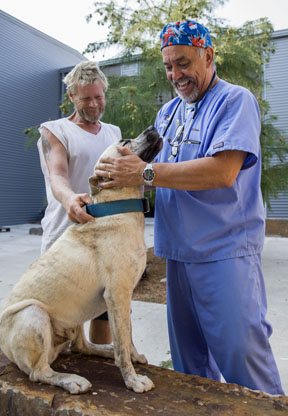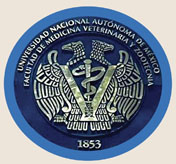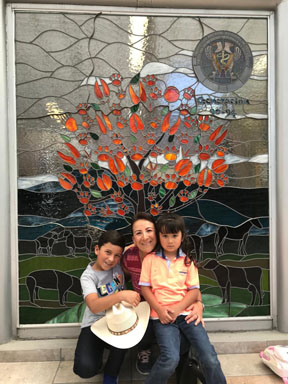Dr. Leonardo Baez

Photo by Chad Bennett
Dr. Leonardo Baez takes care of a dog belonging to a client receiving services at an Oklahoma City homeless shelter, where the doctor offers care once a week. "There is absolutely no question in my mind that you get what you give, and that's been my motto for my whole life," Baez says.
Third of three parts
Lee este artículo en español
Long before the Universidad Nacional Autónoma de México achieved U.S. accreditation of its veterinary program, easing the way for its graduates to practice abroad, intrepid UNAM alumni emigrated to pursue their profession, inspired by a spirit of adventure, a desire to improve their economic prospects and, in at least one case, love.
The VIN News Service spoke with two UNAM graduates who completed their degrees years before the program was accredited by the American Veterinary Medical Association Council on Education in 2011. Here are their stories.
'God put some angels in my life'
Dr. Leonardo Baez's journey to a career in the United States began in a discotheque in his hometown of Cuernavaca, a city in central Mexico known as "the town of eternal spring" for its mild climate and lush gardens. One summer night, when Baez was a veterinary student, he met a young woman with blond curly hair, wearing a black striped dress. She was an American named Margaretta, vacationing with her parents.
Margaretta introduced her new friend to her folks. He found them "very cool" and became close with the whole family. The following summer, they invited him to visit their home in Oklahoma City, Oklahoma.
While there, Baez asked to see some veterinary clinics. First, they visited the family's veterinarian in town. The doctor apparently was charmed by the talkative, eager student and offered, "When you finish school, come by and we can get you work here."
The family also visited Alva, a cattle town where Margaretta's grandmother lived, stopping into more clinics. Baez was particularly taken by a mixed animal practice because he liked large animals. That owner, too, encouraged the young man to return when he finished his studies.
Graduating in 1978 at the age of 21, Baez hustled back to Alva on a tourist visa. The practice promptly hired him as a veterinary assistant. Unauthorized to work in the country, Baez was paid minimum wage in cash, about $100 a week. "I was doing everything for the guy — I mean, everything. We processed hundreds and hundreds of heads of cattle in the mornings, and in the afternoons, we did small animal. It was really, really fun for me because I was young and foolish," he said cheerfully.
Wanting to work legally, Baez approached the Oklahoma Board of Veterinary Examiners for guidance. "They didn't know what the hell to do with me," he recalled. "There'd never been a foreign veterinarian applying to work as a licensed veterinarian in Oklahoma."
Finally, he said, the board simply asked for his academic record and a copy of his Mexican license, and directed him to take the national licensing exam. (Today, graduates of schools that are not U.S.-accredited must pass a slate of tests to qualify for the national licensing exam. The AVMA established in 1973 an Educational Commission for Foreign Veterinary Graduates educational equivalency assessment but Baez said the state didn't require him to first become certified under that program.)
Baez took the national licensing exam as soon as he could, without studying. "I didn't expect to pass... I had no idea what the test was going to be about, so I took it [to find out]," he explained.
What he found out was a shocker. "The stuff — the internal medicine, the pharmacology — all those things were 100% different. We barely touched on internal medicine in Mexico. All of a sudden, I'm seeing diabetes, thyroids, things like that," he said. "I figured the only way I can do this is to go back to school."
Baez contacted a faculty member at Oklahoma State University College of Veterinary Medicine, Dr. Thomas Monin, and once again, found a friend. Monin was the campus contact for veterinarians educated in foreign programs unaccredited by the AVMA. He arranged for Baez to join the senior students on clinical rotation.
"There was nothing formal; it was free," Baez said. "He was an angel. I always tell people, 'God put some angels in my life.' "
Following a semester of work and studying, "grinding, grinding, grinding," he took the licensing exam. "I passed it!" he reported jubilantly. "I think it was 7.2, and passing was 7.1. I didn't excel on it, but my God!"
The next hurdle was the state licensing exam, which included an oral component conducted before five jurors. This time, there were no angels.
"Each person asked you different questions. I did well with everybody but this particular doctor ... he would ask me things about rabies, and I would answer, and then he'd ask me things about brucellosis, and I'd answer, and then he'd say, 'I think your English will interfere with your care of the herd or the pet.' "
The panel denied Baez a license. Irrepressible, he resumed working as a veterinary assistant, repeating the $300 state exam the following year. Again, Baez did not pass.
By this time, he had married Margaretta. Her father was a retired police captain. Upon hearing his son-in-law's plight, he made an appointment with their congressman. That's when Baez learned that state board members were appointed by the governor.
He suspects that political maneuvering came into play because, he said, shortly after the appointment ended, "I got a call from the secretary of the board: 'Dr. Baez, your license is ready.' ... Just like that!" he exclaimed. "Holy shit!"
UNAM Statue

From there, now six years since graduation, Baez's career prospered. His wife being tired of Alva, they were back in Oklahoma City, where he landed a veterinary position that paid $35,000 a year, with health insurance and a retirement plan: "It was like, oh my God, we have arrived!"
They bought their first home, a condominium, for $52,000. Feeling daring, he also acquired a clinic for $30,000, leasing the equipment. He ran the business for six years before being lured out of practice by the pet food company Iams, which recruited him to help open markets in Latin America. That was followed by a stint with the organization that ran the North American Veterinary Conference at the time, doing meeting programming in Latin America and coordinating publication of The Compendium of Continuing Education in Spanish and Portuguese.
Along the way, the Baezes had three daughters. His wife urged him to travel less, so they set up an emergency veterinary practice with two locations, which he led for 13 years before selling.
Baez tried to retire in 2013, but there was only so much tennis he could play. So the couple founded another clinic, Midtown Vets, in Oklahoma City. Five years later, the veterinary consolidator Pathway Vet Alliance (since renamed Thrive Pet Healthcare) offered to buy the practice at a price that was more than 12 times Baez's investment in the business. He accepted.
Baez remains busily employed at Midtown as the medical director.
From Mexico to Canada by way of New Zealand
Maria Segura and kids

Photo by Edgar Ramirez
Dr. Maria Segura, shown with her children, Emilio and Mariana, outside the UNAM veterinary library during a campus visit in 2019, recalls her university days with affection and pride.
Growing up on a farm outside Mexico City, surrounded by animals large and small, Dr. Maria Segura knew from a young age that she would become a veterinarian, just like her father.
There was a short time during her rebellious teen years when she declared, "I am not going to be a vet." Her grandma agreed. "Don't be a vet, honey," she counseled. "They don't make good money here in Mexico. You will starve. Don't be a vet."
But the mood passed, and Segura, just like her father, enrolled in veterinary school at UNAM. She looks upon her university experience during the 1990s as the best days of her life.
The highlight was hands-on field learning. Segura said UNAM owns farms throughout the country. "They have pig farms, sheep farms, dairy farms, goat farms. I'm sure they have something fish," she recounted. "They have bees. Rabbits. And chickens."
In her final year of school, she spent six months on a farm near the Gulf of Mexico, learning about cattle care and visiting private farms to provide community service, putting her learning into action. "We had to assess the whole management of each farm, so we had to talk to the farmer, we had to assess the cows, assess all the people who were working [there]," talking to them about "when they were worming, when they were doing the vaccine program. It was amazing," she raved.
"We always had at least one professor with us, but there were also students doing their master's ... or even their PhDs. We were 16 students the whole semester. We became a family."
Upon graduating in 2000, Segura began working with a cousin who also is a veterinarian. The duo made "almost no money. ... We were barely making enough to pay for the cellphone, my gas and for us to go to the movies," she said, laughing at the memory.
As a girl, she had ambitions to work outside Mexico. As an adult, she began thinking seriously about how to do that. Just before graduating from UNAM, she did an externship at Louisiana State University School of Veterinary Medicine, giving her a taste of living in another country. But she didn't feel accepted by the other students, so the experience wasn't great. However, while at LSU, she learned that it was possible for a veterinarian to earn US$100,000 a year.
"I went back home, and that's when I realized that I really needed to make more money, and [have] a better life, as well. And that was really going to give me what I wanted, because I love being a vet. I don't think I can do anything else," Segura said.
Given a chance to visit New Zealand with a colleague who was traveling there to buy horses, Segura took it. "I knew nothing about New Zealand," she said. "I didn't know where on Earth it was. So I looked it up, and I went there for three weeks, and I loved it."
She ended up staying, getting a job at a racetrack riding horses and breaking in yearlings, for NZ$10 per horse per day. To obtain a veterinary license in the country, she would have to pass multiple exams. She began studying.
The whole process took two 2½ years and NZ$15,000 in fees because she didn't pass all the tests on the first try. But once licensed, she landed the job of her dreams, taking care of horses, llamas, alpacas, sheep and the occasional cow. The position paid $85,000 and included a car and a cellphone.
For 10 years, Segura practiced in New Zealand, starting a family there with her banker husband whom, she jokes, she "imported" from Mexico.
With the arrival of their first child, the couple wanted to be closer to their relatives in Mexico. Segura wasn't interested in living in the U.S. owing to her experience in Louisiana, so they chose Canada, moving in 2012.
"And guess what," Segura said. "I had to do it all over again."
Meaning that to be licensed, she had to sit for multiple exams once more. She even had to take a test to demonstrate her proficiency in the English language.
Segura recognizes how much easier it is for UNAM alumni today to get licensed outside of Mexico. She hopes they recognize it, too. "I have a Mexican friend, I just met her a few months ago, and she graduated after the university was accredited, and all she had to do was pass her English exam and her NAVLE [North American Veterinary Licensing Exam], and now she's working here [in Canada]," she said. "So those students are very, very lucky. Because I went to hell and back. Twice."
Once licensed in Canada, Segura worked relief at a small animal practice, helped establish a hospital at a local humane society and served as a racetrack veterinarian.
Today, she cares for horses, dogs and cats as a locum practitioner and runs a mobile practice providing palliative and end-of-life care. She lives on a farm outside of Ottawa with her husband, two children, two dogs and a horse.